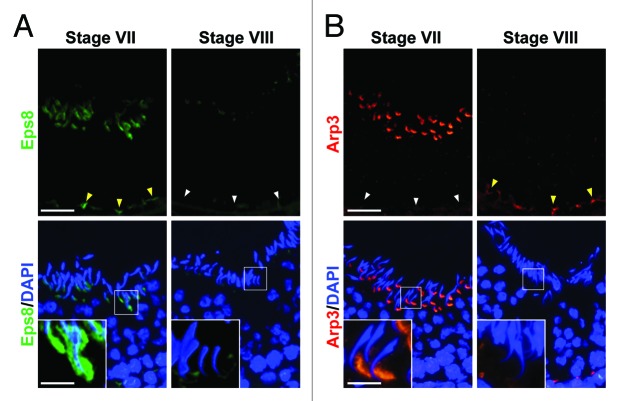Figure 2. Stage-specific/spatiotemporal expression of Eps8 and Arp3 in the rat testis. (A) At stage VII, Eps8 (green fluorescence), an actin barbed end capping and bundling protein, highly expressed at the spermatid head (apical ES) to confer adhesion, and also at the basal ES to confer BTB integrity (“yellow” arrowheads) in the seminiferous epithelium via its intrinsic activity to maintain the integrity of the actin filament bundles at the ES. At stage VIII, Eps8 expression was almost undetectable: (1) at the apical ES to facilitate spermiation, and (2) at the basal ES (“white” arrowheads) to facilitate BTB restructuring to allow the crossing of preleptotene spermatocytes that allows actin filaments to be converted from their “bundled” to their “de-bundled/branched” configuration mediated by the Arp2/3 complex. (B) Arp3 (red fluorescence), known to induce branched actin polymerization, converting actin bundles to a branched state, its expression was virtually not detected at the basal ES when BTB was intact at stage VII (see “white” arrowheads) of the cycle, but its expression was high at the concave side of the spermatid head via its intrinsic activity that converts actin filaments from their “bundled” to their “de-bundled/branched” configuration, destabilizing the actin cytoskeleton at the site, where endocytic vesicle-mediated protein trafficking is known to take place, so that “old” apical ES proteins are recycled to assemble “new” apical ES ; and Eps8 at the convex side of spermatid head continues to maintain spermatid adhesion via its intrinsic activity to confer actin fialments into their “bundled” configuration. At stage VIII, the expression of Arp3 was diminished and not detectable at the apical ES due to spermiation but Arp3 expression was high at the basal ES to induce BTB restructuring (“yellow” arrowheads). In short, utilizing the stage-specific and spatiotemporal expression of these two actin regulatory proteins that have antagonistic effects on the configuration of actin filament bundles at the ES, they confer “plasticity” to the apical and the basal ES during the epithelial cycle of spermatogenesis to accommodate changes in the adhesion function at the Sertoli-spermatid and Sertoli-Sertoli cell-cell interface to facilitate germ cell adhesion/transport in the epithelium. Bar in (A) and (B), 50 μm; inset in (A) and (B), 15 μm, the magnified view of the corresponding boxed area; which apply to remaining micrographs in both panels.

An official website of the United States government
Here's how you know
Official websites use .gov
A
.gov website belongs to an official
government organization in the United States.
Secure .gov websites use HTTPS
A lock (
) or https:// means you've safely
connected to the .gov website. Share sensitive
information only on official, secure websites.
